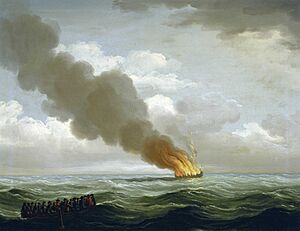Molasses Act facts for kids

|
|
| Long title | An act for the better securing and encouraging the trade of his Majesty's sugar colonies in America. |
|---|---|
| Citation | 6 Geo II. c. 13 |
| Introduced by | The Rt Hon. Sir Robert Walpole, KG, KB, MP |
| Territorial extent | British America and the British West Indies |
Quick facts for kids Dates |
|
| Royal assent | 17 May 1733 |
| Commencement | 24 June 1733 (in part) 25 December 1733 (entire act) |
|
Status: Repealed
|
|
The Molasses Act of 1733 was a law made by the Parliament of Great Britain. It placed a tax of six pence on every gallon of molasses imported from colonies that were not British. This law was mainly pushed by large plantation owners in the British West Indies.
The Act was passed not to collect money, but to control trade. It aimed to make British sugar products cheaper than those from French colonies. This law greatly affected the important colonial molasses trade in America.
Contents
Understanding the Molasses Act
The Molasses Act was a key part of how Britain tried to control trade with its American colonies. It was meant to help British sugar producers.
Why the Molasses Act Was Created
British plantation owners in the West Indies grew a lot of sugar. They wanted to make sure their sugar and molasses were bought by the American colonies. However, the American colonies often bought cheaper molasses from French, Dutch, or Spanish islands.
The British Parliament passed the Molasses Act to make foreign molasses more expensive. This would encourage American colonists to buy from British islands instead. The tax was very high, making it hard for colonists to afford non-British molasses.
The Triangular Trade System
The Molasses Act was connected to a big trade system called the Triangular Trade. This system linked Europe, Africa, and the Americas.
- Merchants bought raw sugar or molasses from plantations in the Caribbean.
- They shipped these goods to New England and Europe.
- In New England, molasses was used to make rum.
- Merchants then used profits from sugar sales to buy rum, furs, and lumber.
- These goods were shipped to Europe.
- From Europe, manufactured goods like tools and weapons were bought.
- These goods, along with American sugar and rum, were taken to West Africa.
- In Africa, these goods were traded for enslaved people.
- The enslaved people were then transported across the Atlantic to the Caribbean or American colonies. This difficult journey was known as the Middle Passage.
- Once in the Americas, the enslaved people were sold to plantation owners.
- The money from these sales was used to buy more raw materials, starting the cycle again.
The Molasses Act aimed to control one part of this complex trade. It tried to force the American colonies to rely only on British sources for molasses.
Impact on the American Colonies
The Molasses Act had a big impact on the American colonies. Many colonists did not like the law.
Colonial Opposition and Smuggling
The tax threatened to harm New England's economy, especially its rum industry. Molasses from British islands was much more expensive. Also, British islands did not need the large amounts of lumber and fish that the American colonies offered in trade.
Because the tax was so high, colonists often refused to pay it. Instead, they turned to smuggling. They would secretly bring in molasses from non-British islands. Customs officials were often bribed or intimidated, which made the law very hard to enforce.
Historian John C. Miller noted that the tax "threatened New England with ruin." It also made the British West Indies richer at the expense of the mainland colonies.
Road to Revolution
The widespread smuggling and disrespect for British laws, like the Molasses Act, grew over time. This growing tension between the colonies and Britain eventually led to the American Revolution in 1776.
The Molasses Act was later replaced by the Sugar Act of 1764. The Sugar Act actually lowered the tax rate. However, Britain was much more serious about collecting the tax this time, which caused even more anger among the colonists.
Images for kids
See also
 In Spanish: Acta de la Melaza para niños
In Spanish: Acta de la Melaza para niños



